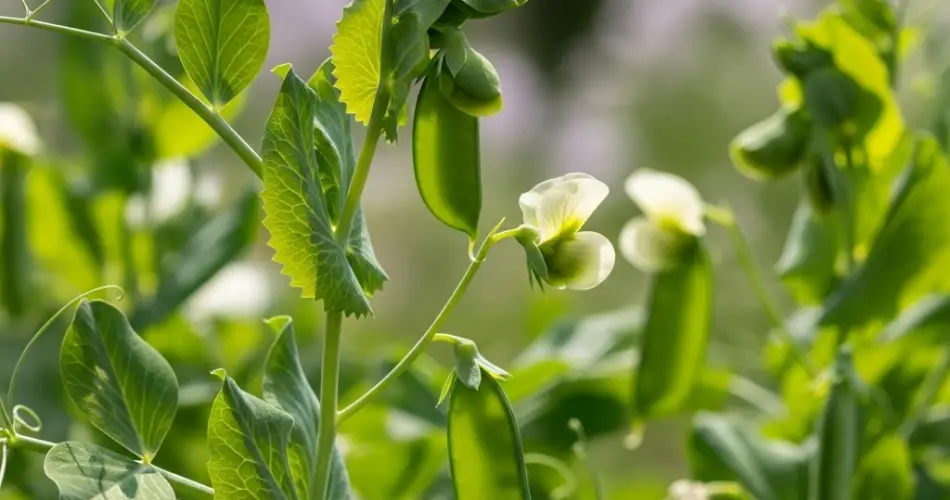Garden peas are a favorite among home gardeners thanks to their sweet taste, ease of cultivation, and ability to improve soil fertility by fixing nitrogen. However, like all plants, peas can face several growing challenges. From pests to poor germination, understanding the common issues that affect pea plants—and how to fix them—can mean the difference between a thriving harvest and a disappointing season.
Here’s a practical guide to identifying and solving the most common problems when growing garden peas.
1. Poor Germination
Pea seeds sometimes fail to sprout due to unfavorable soil conditions or old seeds.
Causes:
-
Cold, wet soil that causes seeds to rot
-
Soil that is too dry
-
Using old or poor-quality seeds
Solutions:
-
Plant seeds when soil temperatures reach at least 45°F (7°C) for best germination.
-
Avoid planting in waterlogged soil. Use raised beds or improve drainage if necessary.
-
Soak seeds overnight before planting to speed up germination.
-
Always use fresh seeds and store them in a cool, dry place.
2. Yellowing Leaves
Yellow leaves are a common sight in pea plants and can signal several issues, including poor soil nutrition or root stress.
Causes:
-
Overwatering or poor drainage
-
Nitrogen deficiency
-
Root rot caused by fungi in wet soil
Solutions:
-
Water consistently but avoid waterlogging the soil. Peas like moist, not soggy, soil.
-
Incorporate compost or a balanced organic fertilizer before planting.
-
Use well-draining soil and avoid planting in the same spot year after year to prevent soil-borne diseases.
3. Wilting Plants
If your pea plants suddenly collapse, especially on warm days, it’s important to act quickly.
Causes:
-
Fusarium or other soil-borne wilts
-
Root damage from pests
-
Drought stress or inconsistent watering
Solutions:
-
Remove and discard affected plants immediately to prevent the spread of fungal pathogens.
-
Rotate crops each season and avoid planting peas in the same area for at least 2–3 years.
-
Ensure soil stays evenly moist and mulch around the base of the plants to retain water.
4. Powdery Mildew
Powdery mildew appears as a white, dusty coating on the leaves and stems of pea plants, often later in the growing season.
Causes:
-
High humidity and poor air circulation
-
Warm days and cool nights
Solutions:
-
Improve airflow by spacing plants appropriately.
-
Avoid overhead watering—water at the base of the plants instead.
-
Apply organic fungicidal sprays like neem oil or a baking soda solution if mildew appears.
5. Aphid Infestations
Aphids are tiny sap-sucking insects that gather on tender shoots and under leaves, weakening plants and transmitting disease.
Signs:
-
Curled, yellowing leaves
-
Sticky residue (honeydew)
-
Presence of ants around the plants
Solutions:
-
Spray with a strong stream of water to dislodge aphids.
-
Use insecticidal soap or neem oil to control infestations naturally.
-
Encourage beneficial insects like ladybugs and lacewings that feed on aphids.
6. Pea Moth and Maggots
Pea moths lay eggs on flowers, and the hatched larvae burrow into developing pods and eat the peas from within.
Prevention and control:
-
Use insect-proof netting to cover plants during flowering when moths are most active.
-
Harvest pods promptly to reduce exposure.
-
Destroy affected pods to prevent further infestation.
7. No Flowers or Poor Pod Formation
Sometimes pea plants grow lush and green but produce few flowers or pods.
Causes:
-
Too much nitrogen in the soil
-
Lack of pollination or poor weather during flowering
-
High temperatures
Solutions:
-
Avoid over-fertilizing with nitrogen-heavy feeds—use a balanced fertilizer instead.
-
Encourage pollinators by planting flowers nearby.
-
Choose heat-tolerant varieties if you’re gardening in warmer regions and provide partial shade during hot spells.
8. Leggy or Weak Growth
Pea plants that grow tall and spindly with few leaves or flowers may be suffering from a lack of light or support.
Causes:
-
Insufficient sunlight
-
Overcrowding
-
Lack of trellising or support
Solutions:
-
Ensure plants receive at least 6 hours of sunlight per day.
-
Thin seedlings to prevent overcrowding and improve air circulation.
-
Provide a trellis, netting, or stakes for climbing varieties to support healthy vertical growth.
9. Birds and Other Pests
Birds love young pea shoots and can quickly decimate your crop, especially just after sprouting.
Prevention tips:
-
Use floating row covers or mesh netting to protect young plants.
-
Install garden scare devices like reflective tape or pinwheels.
-
Surround garden beds with companion plants like garlic or onions to deter pests.
10. Early Bolting
Peas that flower and seed too early (bolting) typically do so in response to environmental stress.
Causes:
-
Hot weather
-
Irregular watering
-
Poor soil fertility
Solutions:
-
Plant early in spring or in late summer for fall harvests to avoid heat.
-
Keep soil evenly moist and use mulch to moderate temperature swings.
-
Choose slow-to-bolt or heat-tolerant pea varieties.
Conclusion
Garden peas are a low-maintenance crop, but they still need the right conditions to thrive. By learning to recognize early signs of problems like pests, disease, poor soil, or environmental stress, you can take proactive steps to protect your plants. With proper care—good watering habits, crop rotation, soil management, and pest prevention—you’ll enjoy a healthy and bountiful harvest of sweet, crunchy peas from your home garden.



